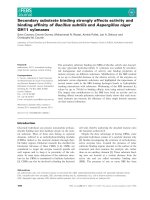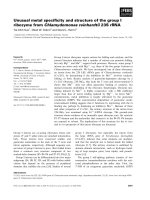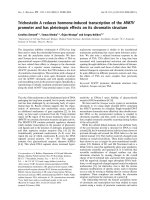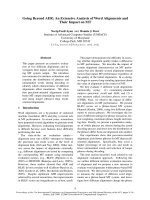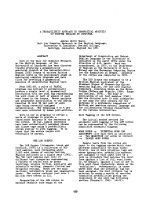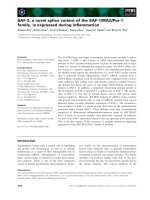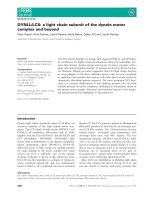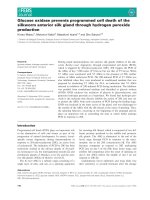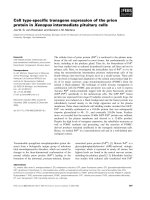Báo cáo khoa học: Comparative metal binding and genomic analysis of the avian (chicken) and mammalian metallothionein potx
Bạn đang xem bản rút gọn của tài liệu. Xem và tải ngay bản đầy đủ của tài liệu tại đây (659.24 KB, 13 trang )
Comparative metal binding and genomic analysis of the
avian (chicken) and mammalian metallothionein
Laura Villarreal
1
, Laura Tı
´o
2
, Merce
`
Capdevila
1
and Sı
´lvia
Atrian
2
1 Departament de Quı
´
mica, Facultat de Cie
`
ncies, Universitat Auto
`
noma de Barcelona, Bellaterra, Spain
2 Departament de Gene
`
tica, Facultat de Biologia, Universitat de Barcelona, Spain
Metallothioneins (MTs), the ubiquitous metal-binding
proteins first described by Vallee in 1957 [1] constitute
a large superfamily of small, cysteine-rich peptides
present in some prokaryotes and in all eukaryotes
(protista and fungi, plants and animals) examined
so far ( ⁄ metallo.txt).
The current limited knowledge of their origin and
differentiation patterns can mainly be attributed to the
lack of detailed, comparative studies involving MTs
other than mammalian isoforms. Besides, any homol-
ogy-driven structural, biochemical or functional infer-
ence using mammalian data makes little sense when
considering MTs other than those belonging to the
unquestionable family of homology of the vertebrate
forms. Precisely, invertebrate, fungal and plant MTs
exhibit a high sequence heterogeneity, both among
Keywords
dimerization; Gallus gallus; metal binding;
metallothionein; molecular evolution
Correspondence
S. Atrian, Department of Genetics, Faculty
of Biology, University of Barcelona, Avenue
Diagonal 645, 08028-Barcelona, Spain
Fax: +34 934034420
Tel: +34 934021501
E-mail:
Note
L. Villarreal and L. Tı
´
o made equal contribu-
tions to this work.
(Received 20 October 2005, revised 1
December 2005, accepted 2 December
2005)
doi:10.1111/j.1742-4658.2005.05086.x
Chicken metallothionein (ckMT) is the paradigm for the study of metallo-
thioneins (MTs) in the Aves class of vertebrates. Available literature data
depict ckMT as a one-copy gene, encoding an MT protein highly similar to
mammalian MT1. In contrast, the MT system in mammals consists of a
four-member family exhibiting functional differentiation. This scenario
prompted us to analyse the apparently distinct evolutionary patterns fol-
lowed by MTs in birds and mammals, at both the functional and structural
levels. Thus, in this work, the ckMT metal binding abilities towards Zn(II),
Cd(II) and Cu(I) have been thoroughly revisited and then compared with
those of the mammalian MT1 and MT4 isoforms, identified as zinc- and
copper-thioneins, respectively. Interestingly, a new mechanism of MT dime-
rization is reported, on the basis of the coordinating capacity of the ckMT
C-terminal histidine. Furthermore, an evolutionary study has been per-
formed by means of in silico analyses of avian MT genes and proteins. The
joint consideration of the functional and genomic data obtained questions
the two features until now defining the avian MT system. Overall, in vivo
and in vitro metal-binding results reveal that the Zn(II), Cd(II) and Cu(I)
binding abilities of ckMT lay between those of mammalian MT1 and
MT4, being closer to those of MT1 for the divalent metal ions but more
similar to those of MT4 for Cu(I). This is consistent with a strong func-
tional constraint operating on low-copy number genes that must cope with
differentiating functional limitation. Finally, a second MT gene has been
identified in silico in the chicken genome, ckMT2, exhibiting all the features
to be considered an active coding region. The results presented here allow
a new insight into the metal binding abilities of warm blooded vertebrate
MTs and their evolutionary relationships.
Abbreviations
FPD, flame photometric detector; ICP-AES, inductively coupled plasma-atomic emission spectroscopy; MRE, metal-response-element;
MT, metallothionein.
FEBS Journal 273 (2006) 523–535 ª 2006 The Authors Journal compilation ª 2006 FEBS 523
them and in relation to the vertebrate peptides. Since
no definite physiological roles have been assigned to
these proteins, functional constraints or adaptative
trends modulating their evolutionary history are also
difficult to envisage.
Some attempts to characterize the evolution of
vertebrate MTs have been carried out through the
analysis of the maximum parsimony trees construc-
ted with protein and cDNA sequences (http://
www.biochem.unizh.ch/mtpage/poster/posterevol.html).
These studies not only locate fish, amphibian and
avian MTs in increasing proximity to the mammalian
MT radiation, but also propose that all vertebrate
MTs originated from a single ancestor. Unfortunately,
the amount of experimental information on nonmam-
malian MT genes and proteins is still too scarce to
support any hypothesis. In this scenario, avian MTs
gather patent interest, as birds represent a class of
warm-blooded vertebrates that evolved in parallel to
mammals for nearly 310 million years, after the late
Palaeozoic divergence of the respective lineages [2].
Chicken (Gallus gallus) is the model organism for
avian molecular biology, and ckMT has also been the
paradigm for the study of avian MTs (reviewed in
[3]). CkMT was isolated and first characterized in the
early 1970s as not significantly different from the
mammalian (mouse) MT1-MT2 forms [4,5] and was
further identified as a 63-residue long polypeptide,
with 68% sequence similarity and two amino acid
insertions in relation to mouse MT1 [6]. CkMT
cDNA [7] and gene [8] features again suggested great
structural and functional resemblance to the mamma-
lian MT system, since the ckMT gene showed the
same exon ⁄ intron distribution and was apparently
regulated by the same cis elements, responding to the
same stimuli: metal overdose, oxidative stress, gluco-
corticoids and lipopolysaccharides [9,10]. Only two
differences were mentioned, the ontogenic expression
pattern of liver ckMT, acutely increasing after hatch-
ing [11], and the apparently solid evidence that MT
was a one-copy gene in birds [6,7]. Studies on other
genera (Meleagris gallopavo (turkey), Phasianus colchi-
cus (pheasant), Colinus virginianus (new world quail)
[11]; Cairina moschata and Anas platyrhyncos (ducks)
[12]; and Coturnix coturnix (quail) [13]) showed an
exceptional conservation rate for the unique MT form
isolated in each of them: no amino acid substitutions
and 97% identity at cDNA level, features which were
readily justified by the functional constraint imposed
on a single copy gene. Description in Columba livia
(pigeon) of two MT isoforms, neither of them coinci-
dent with the previously reported MT sequence [14],
has been the unique evidence of MT multiplicity in
an avian genome, and also of sequence diversity
among avian MTs. This apparent simplicity of the
MT system in birds contrasts with its complexity in
mammals, where duplication events originated a four-
member cluster (MT1 to MT4), with a further 13-fold
amplification of MT1 in humans. Physiological differ-
entiation has been shown for the four isoproteins: the
MT1-MT2 ubiquitous, metal-induced forms have been
related to homeostasis, transport and detoxification of
metal ions; MT3, only synthesized in neural tissues,
has been related to neuronal growth; and a role for
MT4 in the differentiation of stratified squamous epi-
thelia, the only tissue in which it is expressed, has
been suggested. We have proposed a further differen-
tiation between MTs, which has ended in the classifi-
cation of mammalian MT1 as optimum for divalent
metal coordination (zinc-thionein behaviour [15]), and
of MT4 as prone for copper-binding, or with a
copper-thionein character [16].
In view of the distinct evolutionary patterns
followed by MTs in birds and mammals, we decided
to focus our interest on the determination of the metal
coordination features of ckMT, using the same meth-
odological approach previously applied for mammalian
MTs. By this study, we aimed to answer two main
questions. First, to determine the metal binding beha-
viour, preferences and peculiarities of the single avian
MT form, since absence of duplication may have
prevented metal binding specialization. and second, to
elucidate if the avian MT appeared functionally closer
to MT1, as previously reported in the literature, or to
MT4, its closest neighbour according to phylogenetic
and protein distance trees mentioned above. CkMT
characterization was accomplished by determination
of the spectroscopic and spectrometric features of the
Zn-, Cd- and Cu- complexes rendered by the recom-
binant full-length protein and its separate b and a
domains, as well as of the metal species obtained by
Zn ⁄ Cd or Zn ⁄ Cu in vitro replacement.
In the course of this research, the annotation of
the complete chicken genome was released [2], allow-
ing us an exhaustive in silico search for MT-like
sequences as well as the determination of synteny
relationships between the MT gene containing regions
in the human, rat and mouse genomes. Thus, evalua-
tion of the avian versus mammalian MT functional
differentiation trends could be completed by compar-
ative genomics analyses. Remarkably, the joint con-
sideration of all the data here reported basically
reformulates the two main features defining until now
avian MTs: the full functional equivalence with mam-
malian MT1 and the singularity of MT genes in
avian genomes.
Chicken metallothionein L. Villarreal et al.
524 FEBS Journal 273 (2006) 523–535 ª 2006 The Authors Journal compilation ª 2006 FEBS
Results and discussion
Metal binding analysis rationale
The metal binding abilities of ckMT were analysed fol-
lowing a two-step strategy. First, the in vivo synthes-
ized M-ckMT, M-ackMT and M-bckMT complexes
(M ¼ Zn
II
,Cd
II
or Cu
I
) were characterized. Second,
the in vitro Zn ⁄ Cd and Zn ⁄ Cu replacement processes
of the three Zn-ckMT peptides, at pH 7, were analysed
as previously described for MT1 and MT4 [16–20].
Spectroscopic data provided information on the num-
ber of in vivo and in vitro metal–MT generated species,
their stoichiometry, and their degree of folding. Addi-
tionally, the spectrometric measurements revealed the
composition of the recombinant samples and the
molecular distribution [21,22] of the various complexes
present at each point of the titrations. Although it was
possible to determine the Zn:Cd:MT ratio in the heter-
ometallic Zn,Cd–ckMT species, the proximity between
the atomic weights of zinc and copper and the ESI-MS
experimental error range prevented determination of
the Zn:Cu ratio in the heterometallic Zn,Cu–ckMT
species.
Zn(II) and Cd(II) binding abilities of ckMT and its
separate domains
Synthesis of ckMT, ackMT and bckMT both in Zn-
and in Cd- supplemented media yields as major species
the canonical complexes expected for a vertebrate MT,
i.e. M
7
–ckMT, M
4
–ackMT and M
3
–bckMT, where
M ¼ Zn or M ¼ Cd (analytical results included in
Table 1 and Table S1). This behaviour coincides with
that reported for mammalian MT1 and differs from
that regarding MT4. The additional presence of minor
sulphide-containing species in all preparations except
in Zn
4
–ackMT is in accordance with a recent study
reporting that most recombinant MT samples include
these acid-labile ligands [23]. Quantification by GC-
FPD confirms the presence of sulphide in all the prep-
arations, even in Zn
4
–ackMT (Table 1), and suggests
that they may harbour a more significant role in the
Cd- than in the Zn- complexes.
The CD spectra of the M–ckMT and M–ackMT
preparations (M ¼ Zn, Fig. 1A; M ¼ Cd, Fig. 1B) clo-
sely resemble those of the corresponding MT1 com-
plexes [17,18] and provide evidence that the degree of
folding of ckMT and ackMT upon Zn(II) and Cd(II)
Table 1. Molecular masses and metal (Zn, Cd or Cu) to protein ratios found for the in vivo synthesized ckMT, ackMT and bckMT metal
aggregates. A comprehensive table including the theoretical m calculated from the metal-MT composition, and the metal : MT molar ratios
measured from conventional and acid ICP-AES is available as Supplementary Table S1.
Metal supplemented
in culture media Protein
m
exp
a
Da M ⁄ MT
b
S
2–
⁄ MT
c
M ¼ Zn ckMT 7050.9 ± 0.8 Zn
7
–ckMT (S) 2.5
7083.5 ± 1.4 Zn
7
S
1
–ckMT (s)
ackMT 3744.5 ± 0.7 Zn
4
–ackMT 1.1
bckMT 3597.7 ± 0.8 Zn
3
–bckMT (S) 3.1
3692.6 ± 1.7 Zn
3
S
3
–bckMT (s)
M ¼ Cd ckMT 7378.9 ± 2.4 Cd
7
–ckMT (S) 4.7
7332.4 ± 2.5 Cd
6
S
2
–ckMT
7284.4 ± 5.5 Cd
5
S
4
–ckMT (s)
ackMT 3932.5 ± 0.9 Cd
4
–ackMT (S) 2.9
3884.7 ± 0.0 Cd
3
S
2
–ackMT (s)
bckMT 3738.6 ± 0.3 Cd
3
–bckMT (S) 5.6
3692.7 ± 0.6 Cd
2
S
2
–bckMT (s)
M ¼ Cu ckMT 7231.7 ± 2.1 M
10
–ckMT (S) N ⁄ D
d
7292.0 ± 3.5 M
12
–ckMT
7358.3 ± 1.7 M
11
–ckMT
ackMT 3862.7 ± 2.6 M
6
–ackMT (S) N ⁄ D
3925.2 ± 0.0 M
7
–ackMT
3807.4 ± 0.0 M
5
–ackMT (s)
bckMT 3783.6 ± 1.0 Cu
6
–bckMT (S) N ⁄ D
3845.3 ± 0.9 Cu
7
–bckMT
3719.9 ± 1.0 Cu
5
–bckMT
a
Experimental molecular masses for the Zn–, Cd– and Cu–MT complexes.
b
Metal per MT molar ratio calculated from the mass difference
between holo- and apo-protein. (S) denotes a major species; (s) denotes a minor species.
c
S
2–
to MT ratio measured by GC-FPD.
d
N ⁄ D, Non-
detectable.
L. Villarreal et al. Chicken metallothionein
FEBS Journal 273 (2006) 523–535 ª 2006 The Authors Journal compilation ª 2006 FEBS 525
coordination is closer to that of MT1 than to that of
MT4 [16]. In these samples, the absorptions of the
metal-sulphide chromophores are of such a low inten-
sity that they do not significantly contribute to the
final CD spectra (Type A according to the classifica-
tion proposed in [23]). Conversely, the CD spectra of
the in vivo M–bckMT samples (M ¼ Zn, Fig. 1C;
M ¼ Cd, Fig. 1D) differ significantly from those
obtained for the corresponding mammalian bMT1 and
bMT4 complexes. To analyse the chromophores that
may contribute to these new CD fingerprints, recom-
binant Zn–bckMT was further purified either in
Tris ⁄ chloride or Tris ⁄ perchlorate buffer [24], these two
preparations were, respectively, titrated with
Cd(II) chloride or Cd(II) perchlorate, and all the
metal–bckMT species formed were characterized. The
comparison of the CD fingerprints of the Zn– and Cd–
bckMT species formed in the presence or absence of
chloride ions (data not shown) revealed that, at the
assayed concentrations, these anions have no spec-
troscopically detectable contribution either to the
metal-cluster structure or to its chirality. Then, the
presence of S
2–
ligands in the in vivo Zn–bckMT and
Cd–bckMT samples was considered another plausible
explanation for their uncommon CD fingerprints. To
test this, both preparations were acidified to pH 1.5
and reneutralized to pH 7.5. As there was no signifi-
cant difference between the initial and the final CD
spectra (shown in Fig. 1C for Zn–bckMT) we conclu-
ded that this was not the case. Consequently, the char-
acteristic CD fingerprint of Zn– and Cd–bckMT
should only be attributed to the peculiarities of their
M(SCys)
4
chromophores, with perhaps some contribu-
tion of protein conformation at the lowest wavelengths
[25]. Full comparison of the spectroscopic Cd–bMT1,
Cd–bMT4 and Cd–bckMT features is provided in
Fig. 1D and in note 1 of the supplementary material.
Finally, it is worth noting that in spite of the unusual
Zn– and Cd–bckMT CD fingerprints, summation of
the CD spectra of in vivo M–bckMT and M–ackMT
affords spectra that closely resemble those of the full
length M–ckMT (M ¼ Zn, Cd) (Fig. 1A and 1B), sug-
gesting that both fragments behave independently
when binding Zn(II) or Cd(II), as was the case for
MT1 [18]. This independent behaviour can be extended
to the binding capacity of each domain not only for
the major (Zn
3
–orCd
3
–bckMT + Zn
4
–orCd
4
–
ackMT ¼ Zn
7
–orCd
7
–ckMT) but also for the minor
species (i.e. Cd
2
S
2
–bckMT+Cd
3
S
2
–ackMT ¼ Cd
5
S
4
–
ckMT) (Table 1).
Fig. 1. Comparison of the CD spectra of the biosynthesized (A) Zn–ckMT (solid grey line), Zn
4
–ackMT (dotted line) and Zn–bckMT (dashed
line); (B) Cd–ckMT (solid grey line), Cd–ackMT (dotted line) and Cd–bckMT (dashed line). The spectra depicted in a solid black line in (A) and
(B) represent the sum of the CD spectra of M–ackMT and M–bckMT; (C) Zn–bckMT (solid black line), Zn–bMT4 (solid grey line), Zn
3
–bMT1
(dashed line) and Zn–bckMT reneutralized (dotted line); (D) Cd–bckMT (solid black line), Cd–bMT4 (solid grey line) and Cd
3
–bMT1 (dashed
line).
Chicken metallothionein L. Villarreal et al.
526 FEBS Journal 273 (2006) 523–535 ª 2006 The Authors Journal compilation ª 2006 FEBS
Two main results concerning the in vitro binding
abilities of the ckMT peptides deserve explicit com-
ment. First, analysis of the Zn ⁄ Cd replacement in
bckMT (Fig. 2A and 2B, Table S2) further corrobor-
ates the peculiar CD fingerprint of the in vivo Cd–
bckMT sample, since the addition of 3 Cd(II) to Zn–
bckMT renders a mixture of the same composition
(Table S2B), and accordingly equivalent CD spectra
(Fig. 2C) to that of the biosynthesized Cd–bckMT.
Addition of further Cd(II) causes a red shift and a
decrease in the intensity of the main CD signals
(Fig. 2B), giving rise to a spectrum that could be
considered characteristic of the Cd
3
–bckMT species,
with contribution of the Cd
3
S
2
–bckMT complex
(Table S2B), and that is clearly similar to that of Cd
3
–
bMT1 and Cd
3
–bMT4 (Fig. 2D). Second, titration of
Zn–ckMT and Zn
4
–ackMT with Cd(II) renders some
unexpected results suggesting a new MT dimerization
process. During these titrations, the CD spectra of the
samples evolve similarly to those observed for MT1
[17,18] and MT4 [16] in analogous reactions until 7
and 4 Cd(II) respectively added to Zn–ckMT and
Zn
4
–ackMT (Fig. 3A). But after these steps, the addi-
tion of further Cd(II) leads to a marked development
of positive shoulders at 250 nm in both sets of CD
spectra. Since previous studies of Cys-to-His site-
directed MT1 mutants [26] related this absorption to
Cd(II)–NHis coordination, it was reasonable to
hypothesize a possible Cd(II) binding role of the ckMT
C-terminal histidine, obviously also present in its a
fragment. To investigate this, the final solutions of the
Cd(II) titrations of Zn
4
–ackMT and Zn
7
–ckMT were
acidified from pH 7 to pH 4 (Fig. 3B), which caused
the disappearance of the 250 nm absorptions and the
preservation of all the other CD features in both cases.
This result is consistent with Cd–His coordination
being responsible for the 250-nm shoulder, since this
amino acid protonates at a 4–5 pH range, while the
lower pK
a
of the cysteinic thiolates still allows for
maintenance of the Cd–SCys bonds at this pH. Inter-
estingly, the appearance of these 250-nm absorptions is
accompanied by a gradual decrease in the intensity of
the CD envelopes. This variation has been related to
MT dimerization events [27], and coincidently the ESI-
MS results of our samples (Table S2A; Fig. 3C) reveal
the presence of dimeric Cd
8
–(ackMT)
2
species whose
abundance increase with the addition of further Cd(II)
equivalents to Zn
4
–ackMT. Unfortunately, dimers
of the full-length ckMT could not be detected
(Table S2C). Furthermore, acidification of the sample
corresponding to the final step of the Cd(II) titration
of Zn
4
–ackMT give rise to ESI-MS data that show the
disappearance of the Cd
8
–(ackMT)
2
species, thus con-
firming that the dimeric forms are responsible for the
250 nm CD absorption. Two types of dimerization
processes have been reported in MT literature: oxida-
tive dimerization upon disulfide bridge formation [28]
and metal-mediated dimer formation [29]. Our results
are consistent with a third mechanism of MT dimeriza-
tion, mediated by the C-terminal histidine. As once
the dimerization process starts being spectroscopically
detectable the formation of new chromophores stops,
as shown in the CD and UV–vis difference spectra
(Fig. 3A), we may assume a dimerization model
(Scheme 1) involving a simultaneous intermolecular
formation (N
a1
–Cd
a2
and N
a2
–Cd
a1
) and intramolecu-
lar loss (N
a1
–Cd
a1
and N
a2
–Cd
a2
) of two Cd–NHis
bonds, via the second nitrogen donor atom of two His
residues. Therefore, in the dimeric species, two histi-
dines would bridge two a fragments, in a similar way
Fig. 2. (A) and (B) CD spectra corresponding
to the titration of Zn–bckMT with Cd(II) at
pH 7. The arrows show the evolution of the
spectra when the indicated number of Cd(II)
equivalents were added. (C) Superimposi-
tion of the spectra recorded after 3 Cd(II)
added to Zn–bckMT (solid grey line) and
the spectra of the biosynthesized Cd–
bckMT (solid black line). (D) Comparison of
the in vitro constituted Cd
3
–bMT complexes
of bckMT (solid black line), bMT4 (dashed
line [16]), and bMT1 (dotted line [18] and
note 2 in supplementary material).
L. Villarreal et al. Chicken metallothionein
FEBS Journal 273 (2006) 523–535 ª 2006 The Authors Journal compilation ª 2006 FEBS 527
Fig. 3. (A) CD and UV–vis difference spectra corresponding to the titrations of Zn–ckMT and Zn
4
–ackMT with Cd(II) at pH 7. Arrows show
the evolution of the spectra when the indicated number of Cd(II) was added. (B) CD spectrum of the acidification of the final solution of the
Cd(II) titration of Zn–ckMT, the arrow shows the evolution from pH 7 to 4. (C) ESI-MS spectra of an aliquot of the solution obtained after
adding 7 Cd(II) to Zn
4
–ackMT.
N
N
S
S
S
Cd
HOOC
N
N
S
S
S
Cd
α
2
α
2
COOH
N
N
S
S
S
Cd
α
1
α
1
HOOC
N
N
S
S
S
Cd
COOH
(1) (2)
Scheme 1. Possible mechanism of dimerization. The Cd-NHis dashed bonds in (1) are broken when those of (2) are formed.
Chicken metallothionein L. Villarreal et al.
528 FEBS Journal 273 (2006) 523–535 ª 2006 The Authors Journal compilation ª 2006 FEBS
to that described for the active centre of superoxide
dismutase [30].
Cu(I) binding abilities of ckMT and its separate
domains
The analytical characterization of the ckMT species
biosynthesized in Cu-supplemented media is shown in
Tables 1 and S1, none of the Cu–ckMT preparations
showing evidence of sulphide ligands in their com-
plexes. bckMT renders a mixture of homometallic
Cu-species analogous to that obtained for bMT1
[20,31] and bMT4 [16]. However, Cu
6
–bckMT is the
major species, contrasting with the Cu
7
–bMT major
stoichiometry reported for bMT1 and bMT4. This is
consistent with the comparable but nonidentical CD
spectra of these three samples (Fig. 4C). bckMT shows
absorptions in the 330–400 nm range, which suggests
that it would offer the particular Cu(I) binding site
previously reported for bMT4 [16] and absent in
bMT1. In contrast to the b domain, the recombinant
syntheses of ckMT and ackMT in Cu-supplemented
media yield mixtures of heterometallic Zn,Cu–ckMT
species. This behaviour is similar to that of MT1 [20]
and differs from that of the MT4 counterparts [16].
The entire ckMT yields a major M
10
–ckMT species
(M ¼ Zn and ⁄ or Cu) with a Zn
3
Cu
7
–ckMT stoichio-
metry (Table 1), as also reported for MT1 [20] and
Type 2 MT4 [16]. Coincidently, the three Cu–MT com-
plexes afford comparable CD spectra (Fig. 4A). The
ackMT peptide renders M
6
–ackMT as the most abun-
dant species, contrasting with the biosynthesized major
M
5
–aMT1 complex [20]. On the basis of the plasma-
atomic emission spectroscopy (ICP-AES) data (0.5 Zn
and 5.7 Cu for ackMT versus 0.5 Zn and 4.5 Cu for
aMT1), the difference in the M ⁄ aMT stoichiometry
could be explained by the presence of one additional
Cu(I) ion in ackMT. Comparison of CD spectra
(Fig. 4B) reveals that in the presence of Cu(I), ackMT
folds more similarly to aMT4 than to aMT1, in spite
of the hetero versus homometallic nature of both com-
plexes.
In spite of the structural dissimilarities between Zn–
bckMT, Zn–bMT1 and Zn–bMT4 (Fig. 1C) and as
otherwise expected from their similar in vivo Cu(I)
binding behaviour, all three peptides give rise to anal-
ogous Zn ⁄ Cu replacement reactions, with only a slight
difference in the number of Cu(I) required to achieve
some particular titration stages (the full set of spectro-
scopic data and the spectrometric data recorded at
some titration stages are given in Fig. S1 and
Table S3, respectively). Particularly, it is worth noting
that Cu
7
–bckMT is formed after the addition of only
5 Cu(I) to Zn–bckMT, while species of the same
Cu(I):MT ratio and close peptidic fold are obtained
only after the addition of 6 or 7 Cu(I) to Zn
3
–bMT4
[16] and Zn
3
–bMT1 [20], respectively (Fig. S1B). This
suggests a Cu(I) in vitro binding ability higher for
bckMT than for bMT1 or bMT4. The Zn ⁄ Cu replace-
ment reaction on Zn–ackMT shares more similarities
with that on Zn–aMT1 than with that on Zn–aMT4,
although parallel evolutions until 5 Cu(I) are observed
in the three cases. After that, for 6 Cu(I) added, the
chirality of the aMT4 sample suffers a change that
ackMT and aMT1 also endeavour but after the addi-
tion of 7 or 8 Cu(I), respectively. These results allow
consideration of a Cu(I) binding ability for ackMT
intermediate between those of aMT1 and aMT4.
Finally, the titrations of the full-length Zn–ckMT, Zn–
MT1 and Zn–MT4 also evolve similarly until 7 Cu(I),
a step that leads in all cases to the formation of
Zn
3
Cu
7
–MT complexes, which are also equivalent to
the corresponding in vivo-conformed Zn
3
Cu
7
–MT spe-
cies (Fig. 4A). The differences observed at this stage
should be attributed to the dissimilarity of the starting
species CD spectra, and in the case of MT4, to the
minor contribution at 350(+) nm assigned to the
binding of Cu(I) to the bMT4 domain [16]. This par-
ticular MT4 absorption, which intensifies with the for-
mation of Cu
10
–MT4, is never observed during the
Fig. 4. CD spectra of the recombinant (A) Zn
3
Cu
7
–ckMT (black solid line), Zn
3
Cu
7
–MT4 (dashed line) and Zn
3
Cu
7
–MT1 (dotted line); (B)
Cu–ackMT (black solid line), Cu–aMT4 (dashed line) and Cu–aMT1 (dotted line); and (C) Cu–bckMT (black solid line), Cu–bMT4 (dashed
line) and Cu–bMT1 (dotted line).
L. Villarreal et al. Chicken metallothionein
FEBS Journal 273 (2006) 523–535 ª 2006 The Authors Journal compilation ª 2006 FEBS 529
Cu(I) titration of Zn–MT1, but develops after the
addition of 12 Cu(I) to Zn–ckMT, thus revealing that
ckMT can also provide this special coordination envi-
ronment when large amounts of Cu(I) are present.
Regarding domain dependency ⁄ independency, it was
observed that the separate a and b domains do not
interact with Cu(I) in the same way as they do when
linked together in the full-length ckMT, therefore
exhibiting a dependent Cu-binding behaviour. This
observation becomes obvious from the results of the
biosyntheses in Cu-rich media, as M
10
–ckMT com-
plexes are obtained instead of the theoretical M
12
–
ckMT that would result from the addition of the
major M
6
–ackMT and Cu
6
–bckMT species. Thus, the
ckMT separate domains are characterized by a higher
in vivo Cu(I) binding capacity than when constituting
the entire polypeptide, as was also the case for MT1
[20] and MT4 [16].
Chicken genome search, comparative genomics
and protein sequence analysis
In order to investigate the syntenic relationships
between the chromosomal regions containing the MT
gene ⁄ s in birds and mammals, the recently annotated
chicken genome (v.29.1) was searched using as a
query the ckMT cDNA sequence cloned and heterol-
ogously expressed in this work [7]. Surprisingly,
homology is detected in two unlinked genomic loca-
tions (Fig. 5). One of them (chromosome 11, contig
100.32) contains the expected ckMT gene. Although
the clones of the Data Bank are discontinuous, gene
misidentification was ruled out because the DNA
sequence of exon 3 exactly corresponds to that in the
ckMT cDNA, and besides, the size of the contiguous
nonsequenced segments is sufficient to contain the
remaining gene regions, in view of their small size [3].
The other MT-like sequence includes a complete MT
ORF, which we call ckMT2, and whose translation
fully matches the Columba livia form 1 MT. Conse-
quently, the original ckMT will hereafter be called
ckMT1.
Analysis of the chicken, mouse and human ge-
nomes clearly identifies synteny between a 50-kb ge-
nomic region comprising ckMT1 and the mammalian
MT clusters (111 kb in mouse and 200 kb in
humans), bordered in the three cases by the Bbs2 and
Nup93 genes, that we adopted as flanking markers
(Fig. 5). Therefore, the initial proposal of a unique
MT gene in chicken instead of a MT gene cluster,
remains valid only if considering its mammalian
syntenic region, but not for the whole genome. The
following pieces of evidence highly favour the consid-
eration of ckMT2 as a functional gene: the sequence
identity shared by the putative ckMT2 and Columba
MT1 proteins [14], the integrity of the ckMT2 gene
structural elements, the scarcity of retrogenes in the
chicken genome [2], the existence of a corresponding
chicken EST in the databases, and the identification
in the 5¢-ckMT2 region of canonic cis regulatory
sequences, including those of three metal response ele-
ments (MREs) at positions )269, )130 and )96. A
low and ⁄ or time- and tissue-restricted ckMT2 expres-
sion pattern would plausibly be the reason why its
Fig. 5. Structure and synteny of the chicken, mouse and human genomic regions containing the MT genes. The chromosome number and
bands enclosing the MT cluster are indicated for the mammalian genomes. For the chicken genome, the name of the corresponding contig
is shown, as well as of the known chromosome. Two genes external to the MT cluster have been used as flanking synteny markers.
Chicken metallothionein L. Villarreal et al.
530 FEBS Journal 273 (2006) 523–535 ª 2006 The Authors Journal compilation ª 2006 FEBS
cDNA has remained undetected and thus the corres-
ponding gene gone unnoticed. In fact, the expression
levels of the ortologous Columba MT1 are reported
to be fivefold lower than those of the main avian MT
forms [14].
Finally, the features of the three currently known
avian MT protein sequences (Fig. 6A) were com-
pared to those of mammalian MT1 and MT4 and to
representatives of lower vertebrate MTs. From the
protein distance relationships (Fig. 6B), it is reason-
able to consider Columba MT2 (avMTb in Fig. 6A)
as a slight variant of the predominant avMTa avian
MT form. If so, an early duplication in the avian
lineage would have yielded one MT ( ckMT1) clo-
ser to the amphibian and mammalian MT1–MT2
system and syntenic to the latter, and a second MT
( ckMT2) more similar to the hypothetically pri-
meval mammalian MT4, and chromosomically non-
linked to the previous one. What can no longer be
assumed as a general rule is the alleged single-copy
composition for the avian MT system, although, and
in reflection of the general avian versus mammalian
genome features, it is clear that the MT family has
not expanded in birds as much as in mammals [2].
Conclusions
The main goal of this work was the characterization of
the ckMT metal binding abilities, as a model for avian
MTs, mainly in comparison with the mammalian MT1
and MT4 forms. In mammals, the paradigmatic MT1
has been identified as a Zn-thionein and MT4 as a
Cu-thionein, through the analysis of their in vivo and
in vitro metal binding preferences and in silico consid-
eration of their protein sequences [15]. The main
factors for this classification are the capacity of
Cu-thioneins versus the incapacity of Zn-thioneins to
render homometallic copper complexes when heterolo-
gously synthesized in Cu-supplemented media, as well
as the clustering with known Cu-thioneins (as yeast
Cup1 protein) in protein distance trees. Here we show
that ckMT1 exhibits a Zn-thionein behaviour accord-
ing to these criteria. Nevertheless, the Zn(II) and
Cd(II) binding abilities of ckMT1 are intermediate
between those of MT1 and MT4, but closer to MT1
than to MT4 (cf. stoichiometry, folding and domain
dependency results). The Cu(I) binding studies of
ckMT1 reveal also an intermediate character, but in
this case closer to MT4.
A
B
Fig. 6. (A) ClustalW alignment of the known
avian MT sequences, and the MT1 (P02802)
and MT4 (P47945) mammalian forms. The
shaded boxes indicate the cysteine resi-
dues. The avMTa sequence corresponds to
the MT of Gallus gallus 1 (P68497), Cairina
moschata (P68495), Meleagris gallopavo
(P68498), Anas platyrhynchos (P68494) and
Coturnix japonica (Q5G1K5). The avMTb is
the Columba livia 2 isoform (P15787). The
avMTc sequence is found in the Columba
livia 1 (P15786) and Gallus gallus 2 isoforms.
For avMTb and avMTc only the residues dif-
fering from avMTa are shown. (B) Protein
distance tree constructed with the amino
acid sequences of the avian MT isoforms,
the mammalian MT1, MT2 (P02798) and
MT4 isoforms, the fish MTs of genera Ruti-
lus (P80593), Danio (P52722) and Barbatula
(P25128), and the amphibian Ambystoma
MT (O42152). The bootstrap values of the
branching points are indicated. The
sequence accession numbers in the Uni-
ProtKB ⁄ Swiss-Prot databank are indicated in
parentheses.
L. Villarreal et al. Chicken metallothionein
FEBS Journal 273 (2006) 523–535 ª 2006 The Authors Journal compilation ª 2006 FEBS 531
!
Cu(I)
MT1 ckMT1 MT4
Zn(II); Cd(II)
In conclusion, although a Zn-thionein, ckMT1 is a
better copper-coordinating protein than MT1, which
would allow a compensation for the absence of a
specific Cu-thionein in chicken. The classification of
ckMT1 as a Zn-thionein is in full concordance with
the location of its sequence in the protein distance
trees, closer to the syntenic mammalian MT1 form.
Surprisingly, in silico analyses identify a second MT
gene in chicken, unlinked with the known one, and
with all the features to be considered as a functional
coding region. Investigation on this gene ⁄ protein
should be performed to fully understand the MT
system in birds. Finally, a new dimerization mechan-
ism in MTs, related to Cd(II) coordination by the
C-terminal histidine of ckMT1, has been proposed.
This is noteworthy because a histidine is not only the
most common C-terminal residue among avian MTs,
but also in significant invertebrate representatives, such
as Caenorhabditis elegans MT, the characterization of
which is currently being performed.
Experimental procedures
Bacterial strains and plasmids
The Escherichia coli strains DH5a [32] and JM105 [33] were
used for DNA manipulation and sequencing, and BL21
was used [34] for recombinant protein synthesis. pGEX-4T-
1 (GE-Amersham Biosciences, Europe GmbH, Barcelona,
Spain) was used as expression vector. Recombinant E. coli
strains were grown at 37 °C in Luria–Bertani media with
ampicillin at a final concentration of 100 lgÆmL
)1
. Protein
synthesis was induced by adding 10 mm isopropyl-1-thio-
b-d-galactopyranoside (final concentration) to the cultures.
ZnCl
2
, CdCl
2
or Cu
2
SO
4
were added to final concentrations
of 300 lm, 300 lm and 500 lm, respectively.
Cloning of the chicken MT cDNA and its separate
a and b domains for recombinant expression
The ckMT coding sequence, kindly provided by Dr G.K.
Andrews of the University of Kansas Medical Center [7]
as a pSP6 clone, was amplified by PCR using the fol-
lowing oligonucleotides: upstream primer, ckMT-BamHI
(5¢-GCC
GGATCCATGGACCCTCAGGA-3¢) and down-
stream primer, ckMT-SalI(5¢-GCGCGC
GTCGACTCAG
TGGCAGCA-3¢). Through this reaction, a BamHI restric-
tion site (underlined) was introduced before the ATG initi-
ation codon and a SalI site (underlined) immediately after
the stop codon. A 35-cycle PCR profile of 30 s at 94 °C
(denaturing), 30 s at 60 °C (annealing) and 30 s at 72 °C
(extension) was carried out in a total volume of 100 lL,
comprising 2 lLof25mm dNTP mixture, 2 lLof20lm
primer solution, 1 U of DeepVent DNA polymerase (New
England Biolabs, Hitchin, England) and 100 ng of the tem-
plate DNA. The cDNAs encoding the separate ckMT
domains were obtained by mutagenic PCR on the initial
clone. To amplify the ckMT a fragment, encompassing
from the 32nd MT residue (Lys) to the C terminus, a PCR
reaction was performed with the ackMT-BamHI primer (5¢-
CGCGGATCCATGAAGAGCTGCTGCTC-3¢, upstream)
and the ckMT-SalI primer (downstream). The ckMT b
fragment extends from the ATG initiation codon to the
31st residue (Arg). The primers used for its PCR amplifica-
tion were: ckMT-BamHI (upstream) and bckMT-SalI
(5¢-CCGCGCGTCGACCTAGCGGCAGCTCCCGGCAGC
GG-3¢, downstream). Both PCR reactions were performed
using the same conditions than for the entire ckMT cDNA.
In all cases, the PCR products were isolated from 2% ag-
arose gels with the Gel Band Purification kit (GE-Amer-
sham Biosciences), digested with BamHI and SalI (Takara
Shuzo Co. Ltd, Kyoto, Japan) and subsequently ligated
into the same sites of pGEX-4T-1. All the DNA constructs
were confirmed by automatic DNA sequencing (ABI 370,
Perkin Elmer, Wellesley, MA, USA), using the Dye Termi-
nator Cycle Kit (GE-Amersham Biosciences), to rule out
the presence of PCR induced substitutions.
Synthesis and purification of the ckMT, ackMT
and bckMT metal complexes
Recombinant bacteria were grown both in small-scale cul-
tures (1.5 L in Erlenmeyer flasks) and large-scale cultures
(at least 10 L in a Microferm Fermentor (New Bruns-
wich) coupled to a Westfalia CSA-1-06-475 centrifuge
and controlled by a TVE-OP 76 ⁄ 0 programmer (Braun
Biotech). In both cases, the transformed E. coli cells were
grown as described [16], supplementing the medium either
with ZnCl
2
, CdCl
2
or CuSO
4
as explained above. Purifi-
cation of all the metal–MT complexes was performed as
described for mouse MT1 [17,18], starting from the
recovered GST–MT fusions. At the end, the MT-contain-
ing fractions eluted from a FPLC Superdex
TM
75 column
(GE-Amersham Biosciences) in 50 mm Tris ⁄ HCl buffer
pH 7.0, were analysed by SDS ⁄ PAGE (15% acrylamide).
Samples were pooled, aliquoted and kept at )80 °C
under argon until required.
Analysis of the ckMT, ackMT and bckMT metal
content
Inductively coupled ICP-AES was used to determine the
amount of protein present in the different preparations
Chicken metallothionein L. Villarreal et al.
532 FEBS Journal 273 (2006) 523–535 ª 2006 The Authors Journal compilation ª 2006 FEBS
and the global metal-to-protein ratios, measuring sul-
phur at 182.04 nm, zinc at 213.85 nm, cadmium at
228.80 nm and copper at 324.75 nm. Acid ICP-AES
included a sample acidification (incubation in 1 m HCl
at 65 °C for 5 min) before the conventional ICP proce-
dure [23].
Spectroscopic characterization of the ckMT,
ackMT and bckMT metal complexes
Spectroscopic (UV-Vis) and spectropolarimetric (CD) analy-
sis of the metal–ckMT clusters and of the species formed
in vitro during the Zn ⁄ Cd and Zn⁄ Cu displacement studies at
pH 7.0 were carried out and processed as described [16].
Electronic absorption was measured on an HP-8453 Diode
array UV-visible spectrophotometer. A Jasco spectropola-
rimeter (Model J)715) interfaced to a computer (grams 32
Software) was used for CD determinations. All assays were
performed under argon, and all the titrations were carried
out at least twice. The pH for all experiments remained con-
stant throughout without the addition of buffers, and the
temperature was kept at 25 °C by means of a Peltier
PTC-351S apparatus (TE Technology Inc., Traverse City,
MI, USA).
MS characterization of the ckMT, ackMT and
bckMT metal complexes
The molecular mass of the Zn-, Cd-, and Cu-MT species
obtained in vivo and in vitro was determined by ESI-MS
on a Fisons Platform II Instrument (Fisons Instruments
Inc., Beverly, MA, USA), equipped with masslynx
software and calibrated with horse-heart myoglobin
(0.1 mgÆmL
)1
). The assay conditions for the Zn- and
Cd-containing species were as follows: 20 lL of protein
solution injected at 60 lLÆmin
)1
; the use of an HPLC
Kromasil-100 C
4
(3.5 lm, 5 · 0.21 cm) column (Tekno-
kroma, Barcelona, Spain) to separate analytes; capillary
counter-electrode voltage, 4.5 kV; lens counter-electrode
voltage, 1.0 kV; cone potential, 60 V; source temperature,
120 °C; m ⁄ z range, 850–1950; scanning rate, 3 sÆscan
)1
;
interscan delay, 0.3 s. The assay conditions for the
Cu-containing species were: 20 lL of protein solution
injected at 30 lLÆmin
)1
; capillary counter-electrode volt-
age, 3.5 kV; lens counter-electrode voltage, 1.0 kV; cone
potential, 35 V; source temperature, 160 °C; m ⁄ z range,
850–1950; scanning rate, 3 sÆscan
)1
; interscan delay, 0.3 s.
In all cases, the running buffer was a mixture of aceto-
nitrile and 5 mm ammonium acetate ⁄ ammonia pH 7.5.
The molecular mass of the apo-forms was determined as
for the Cu-containing species, except that the carrier was
a 1 : 1 mixture of acetonitrile and trifluoroacetic acid,
pH 1.5. Masses for the holo-species were calculated as
described in [35].
GC determination of the sulphide content in the
ckMT, ackMT and bckMT metal complexes
The sulphide presence in the ckMT, ackMT and bckMT
metal complexes was quantified by heavy acidification of
the MT preparation, followed by GC and detection of the
volatile H
2
S generated through a flame photometric detec-
tor-GC coupled system (FPD-GC). Analysis conditions are
detailed in [23].
In silico analysis of the chicken genome and
avian MT protein sequences
The last annotated chicken Genome version (29.1e, the Well-
come Trust Sanger Institute, />gallus ⁄ ) was used for in silico searches of MT-like sequences,
through the BLAST facility accessible from the same site.
The sequence of the chicken MT cDNA cloned for recombin-
ant expression in this work (UniProtKB ⁄ Swiss-Prot acces-
sion number P68497) was used as a query. A 500-bp region
upstream the putative transcription initiation site of the iden-
tified MT genes was analysed by using matinspector in the
genomatix WEB interface (v.3.4.1) to search for MRE
boxes [36]. MT protein sequences were aligned with clu-
stalw (v1.81), using the Gonnet series as a distance matrix,
and a gap-penalty of 10 ⁄ 100, a gap-extension value of 0.2 ⁄ 100
and a 30% delay between divergent sequences [37]. The
clustalw alignments were the input for protein distance cal-
culations and construction of the corresponding Neighbour-
Joining tree. A bootstrap test was run and 1000 replica trees
were examined for each bootstrap. The nodes with a boot-
strap number below 500 were collapsed. The protein-distance
and tree-building applications are included in the mega 3
software [38].
Acknowledgements
This work was supported by the Spanish Ministerio de
Ciencia y Tecnologı
´
a grants BIO2003-03892 to Silvia
Atrian and CTQ2005-01946 ⁄ BQU to Merce
`
Capdevila.
We acknowledge the Serveis Cientı
´
fico-Te
`
cnics, Univer-
sitat de Barcelona (DNA sequencing, ICP-AES, ESI-
MS) and the Servei d’Ana
`
lisi Quı
´
mica, Universitat
Auto
`
noma de Barcelona (AAS, CD, UV-Vis) for alloca-
ting instrument time.
References
1 Margoshes M & Vallee BL (1957) A cadmium protein
from equine kidney cortex. J Am Chem Soc 79,
4813–4814.
2 International Chicken Genome Sequencing Consortium
(2004) Sequence and comparative analysis of the
L. Villarreal et al. Chicken metallothionein
FEBS Journal 273 (2006) 523–535 ª 2006 The Authors Journal compilation ª 2006 FEBS 533
chicken genome provide unique perspectives on verteb-
rate evolution. Nature 432, 695–716.
3 Andrews GK, Fernando LP, Moore KL, Dalton TP
& Sobieski RJ (1996) Avian metallothioneins: struc-
ture, regulation and evolution. J Nutr 126, 1317S–
1332S.
4 Weser U, Donay F & Rupp H (1973) Cadmium-induced
synthesis of hepatic metallothionein in chicken and rats.
FEBS Lett 32, 171–174.
5 Weser U, Rupp H, Donay F, Linnemann F, Voelter W,
Voetsch W & Jung G (1973) Characterization of Cd,
Zn-Thionein (Metallothionein) isolated from rat and
chicken liver. Eur J Biochem 39, 127–140.
6 McCormick CC, Fullmer CS & Garvey JS (1988)
Amino acid sequence and comparative antigenicity of
chicken metallothionein. Proc Natl Acad Sci USA 85 ,
309–313.
7 Wei D & Andrews GK (1988) Molecular cloning of
chicken metallothionein. Deduction of the complete
amino acid sequence and analysis of expression using
cloned cDNA. Nucleic Acids Res 16, 537–553.
8 Fernando LP & Andrews GK (1989) Cloning and
expression of an avian metallothionein-encoding gene.
Gene 81, 177–183.
9 Fernando LP, Wei D & Andrews GK (1989) Structure
and expression of chicken metallothionein. J Nutr 119,
309–318.
10 Dalton T, Paria BC, Fernando LP, Huet-Hudson YM,
Dey SK & Andrews GK (1997) Activation of the
chicken metallothionein promoter by metals and
oxidative stress in cultured cells and transgenic mice.
Comp Biochem Physiol 116, 75–86.
11 Shartzer KL, Kage K, Sobieski RJ & Andrews GK
(1993) Evolution of avian metallothionein: DNA
sequence analyses of the turkey metallothionein gene
and metallothionein cDNAs from pheasant and quail.
J Mol Evol 36, 255–262.
12 Lee Y-L, Chen Y-P, Wang S-H, Chow W-Y & Lin L-Y
(1996) Structure and expression of metallothionein gene
in ducks. Gene 176, 85–92.
13 Maxfield LF, Fraize CD & Coffin JM (2005) Relation-
ship between retroviral DNA-integration-site selection
and host cell transcription. Proc Natl Acad Sci USA
102, 1436–1441.
14 Lin L, Lin WC & Huang PC (1990) Pigeon metallothio-
nein consists of two species. Biochim Biophys Acta 1037,
248–255.
15 Valls M, Bofill R, Gonzalez-Duarte R, Gonzalez-Duarte
P, Capdevila M & Atrian S (2001) A new insight into
metallothionein classification and evolution. The in vivo
and in vitro metal binding features of Homarus ameri-
canus recombinant MT. J Biol Chem 276, 32835–32843.
16 Tio L, Villarreal L, Atrian S & Capdevila M (2004)
Functional differentiation in the mammalian Metal-
lothionein gene family. J Biol Chem 279, 24403–24413.
17 Cols N, Romero-Isart N, Capdevila M, Oliva B, Gonz-
alez-Duarte P, Gonzalez-Duarte R & Atrian S (1997)
Binding of excess Cadmium (II) to Cd7-metallo-
thionein from recombinant mouse Zn
7
- metallothionein
1. UV-VIS absorption and circular dichroism studies and
theoretical location approach by surface accessibility ana-
lysis. J Inorg Biochem 68, 157–166.
18 Capdevila M, Cols N, Romero-Isart N, Gonzalez-Duarte
R, Atrian S & Gonzalez-Duarte P (1997) Recombinant
synthesis of mouse Zn
3
-b and Zn
4
-a metallothionein 1
domain and characterization of their cadmium (II) bind-
ing capacity. Cel Mol Life Sci 53, 681–688.
19 Bofill R, Palacios O, Capdevila M, Cols N, Gonzalez-
Duarte R, Atrian S & Gonzalez Duarte P (1999) A new
insight into the Ag
+
and Cu
+
binding sites in metal-
lothionein b domain. J Inorg Biochem 73, 57–64.
20 Bofill R, Capdevila M, Cols N, Atrian S & Gonzalez-
Duarte P (2001) Zn (II) is required for the in vivo and
in vitro folding of mouse Cu-metallothionein in two
domains. J Biol Inorg Chem 6, 405–417.
21 Polec K, Palacios O, Capdevila M, Gonzalez-Duarte P
& Lobinski R (2002) Monitoring of the metal displace-
ment from the recombinant mouse liver metallothionein
Zn
7
-complex by capillary zone electrophoresis with elec-
trospray MS detection. Talanta 57, 1011–1017.
22 Palacios O, Polec K, Lobinski R, Capdevila M & Gon-
zalez-Duarte P (2003) Is Ag (I) an adequate probe for
Cu (I) in structural copper–metallothionein studies? The
binding features of Ag (I) to mammalian metallothion-
ein 1. J Biol Inorg Chem 8, 831–842.
23 Capdevila M, Pagani A, Domenech J, Tio L, Villarreal L
& Atrian S (2005) Zn- and Cd-Metallothionein recombi-
nant species from the most diverse phyla may contain sul-
fide ligands. Angew Chem Int Ed 44, 4618–4622.
24 Villarreal L, Tio L, Atrian S & Capdevila M (2005)
Influence of chloride ligands on the structure of Zn- and
Cd-metallothionein species. Arch Biochem Bioph 435,
331–335.
25 Rupp H & Weser U (1978) Circular dichroism of metal-
lothioneins. A structural approach. Biochim Biophys
Acta 533, 209–226.
26 Romero-Isart N, Cols N, Termansen M, Gelpi JL,
Gonzalez-Duarte R, Atrian S, Capdevila M & Gonzalez-
Duarte P (1999) Replacement of terminal cysteine with
histidine in the metallothionein a and b domain maintains
its binding capacity. Eur J Biochem 259 , 519–527.
27 PalumaaP,MackayEA&VasakM(1992)Nonoxidative
cadmium-dependentdimerizationofCd
7
-metallothionein
fromrabbitliver.Biochemistry31,2181–2186.
28 Hathout Y, Reynolds KJ, Szilagyi Z & Fenselau J
(2002) Metallothionein dimers studied by nano-spray
mass spectrometry. J Inorg Biochem 88, 119–122.
29 Zangger K & Armitage IM (2002) Dynamics of inter-
domain and intermolecular interactions in mammalian
metallothionein. J Inorg Biochem 88, 135–143.
Chicken metallothionein L. Villarreal et al.
534 FEBS Journal 273 (2006) 523–535 ª 2006 The Authors Journal compilation ª 2006 FEBS
30 Ferraroni M, Rypniewski W, Wilson KS, Viezzoli MS,
Banci L, Bertini I & Mangani S (1999) The crystal
structure of the monomeric human SOD mutant
F50E ⁄ G51E ⁄ E133Q at atomic resolution. The enzyme
mechanism revisited. J Mol Biol 288, 413–426.
31 Cols N, Romero-Isart N, Bofill R, Capdevila M,
Gonzalez-Duarte P, Gonzalez-Duarte R & Atrian S
(1999) In vivo copper- and cadmium-binding ability of
mammalian metallothionein b domain. Protein Eng 12,
265–269.
32 Hanahan D (1983) Studies on transformation of
Escherichia coli cells with plasmids. J Mol Biol 166,
557–580.
33 Yanish-Perron C, Viera J & Messing J (1985) Improved
M13 phage cloning vectors and host strains: nucleotide
sequences of the M13mp18 and pUC19 vectors. Gene
33, 103–109.
34 Studier FW & Moffatt BA (1986) Use of bacteriophage
T7 RNA polymerase to direct selective high-level
expression of cloned genes. J Mol Biol 189, 113–130.
35 Fabris D, Zaia J, Hathout Y & Fenselau C (1996)
Retention of Thiol Protons in Two Classes of Protein
Zinc Coordination Centers. J Am Chem Soc 118,
12242–12243.
36 Quandt K, Frech K, Karas H, Wingender E & Wer-
ner T (1995) MatInd and MatInspector – New fast
and versatile tools for detection of consensus matches
in nucleotide sequence data. Nucl Acids Res 23, 4878–
4884.
37 Thompson JD, Higgins DG & Gibson TJ (1994) CLUS-
TAL W: improving the sensitivity of progressive multi-
ple sequence alignment through sequence weighting,
position specific gap penalties and weight matrix choice.
Nucl Acids Res 22, 4673–4680.
38 Kumar S, Tamura K & Nei M (2004) MEGA3: Inte-
grated Software for Molecular Evolutionary Genetics
Analysis and Sequence Alignment. Brief Bioinformatics
5, 150–163.
Supplementary material
The following supplementary material is available
online:
Note S1. Comparison of the CD fingerprints of the
three in vivo Cd–bMT samples: Cd–bckMT, Cd
3
–
bMT1 and Cd
3
–bMT4.
Note S2. Assignment of the CD spectrum of the Cd
3
–
bMT1 species.
Table S1. Molecular masses and metal (Zn, Cd or Cu)
to protein ratios found for the in vivo synthesized
ckMT, ackMT and bckMT metal aggregates.
Table S2. Distribution of the metal aggregates present
in solution, according to ESI-MS data, during the
titration of Zn
4
–ackMT (A), Zn
3
–bckMT (B) and
Zn
7
–ckMT (C) with CdCl
2
at pH 7 as a function of
the number of Cd(II) equivalents added.
Table S3. Distribution of the metal aggregates present
in solution, according to ESI-MS data, during the
titration of Zn
4
–ackMT (A), Zn
3
–bckMT (B) and
Zn
7
–ckMT (C) with [Cu(MeCN)
4
]ClO
4
at pH 7 as a
function of the number of Cu(I) equivalents added.
Fig. S1. CD spectra corresponding to the titrations of
(A) Zn
4
–ackMT (B) Zn
3
–bckMT, and (C) Zn
7
–ckMT
with Cu(I) at pH 7. The arrows show the evolution of
the spectra when the indicated number of Cu(I) equiv-
alents were added.
This material is available as part of the online article
from:
L. Villarreal et al. Chicken metallothionein
FEBS Journal 273 (2006) 523–535 ª 2006 The Authors Journal compilation ª 2006 FEBS 535
